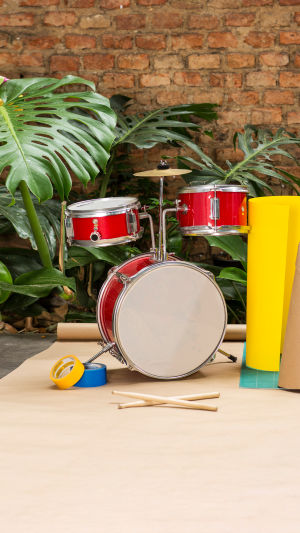A drum kit is a widely embraced percussion instrument, typically comprising an array of differently sized and pitched drums, systematically arranged on a metal or wooden stand, enabling the musician to strike multiple drumheads simultaneously.
The drum kit finds its place in a diverse range of musical genres, from rock and jazz to pop and classical, and its distinctive sounds resonate across the music spectrum.
1. The Evolution of the Drum Kit
The roots of drums can be traced back to ancient civilizations, where they were crafted from animal hides and employed in various cultural and practical contexts, including celebrations, warfare, and entertainment. However, the modern drum kit, as we know it today, began to take shape in the early 20th century.
At the onset of the 20th century, significant changes started to emerge in the construction of drum kits. Drummers began utilizing steel drum racks, enabling them to mount multiple drums and cymbals on a single rack.
This innovation revolutionized drumming by providing drummers the convenience of playing different drums and cymbals without the need for constant relocation. Over time, technological advancements led to increasingly complex drum kit configurations, allowing drummers to customize their instruments by selecting different types and sizes of drums to suit their specific needs.
In the mid-20th century, with the advent of rock and roll, the drum kit assumed a pivotal role within rock bands, catapulting it to even greater importance and popularity in the music realm.
Subsequently, drum kits have become an indispensable element across a wide array of musical genres, spanning rock, jazz, pop, hip-hop, electronic music, and more.
2. Anatomy of the Drum Kit
Drum Shell: The drum shell serves as the core of the drum kit, typically crafted from wood but also available in metal or plastic variations. Different shell materials yield distinct tonal qualities. Wooden shells tend to produce warm and resonant tones, whereas metal shells generate brighter and sharper sounds.
Drum Head: Positioned atop the drum shell, the drum head is typically made from animal hide or synthetic materials. Traditional drums often feature animal hide heads, while modern drums predominantly employ synthetic alternatives. The type of drum head significantly influences the drum's tone and responsiveness.
Rim: The rim, located at the edge of the drumhead, is struck by drummers using sticks or mallets to produce sound. The shape and material of the rim contribute to the character of the sound produced.
Drum Bottom: Situated at the base of the drum shell, the drum bottom lacks a drum head and serves primarily to support the shell and transmit sound.
Drum Stand: The drum stand functions as the framework of the drum kit, providing support for mounting drum shells, cymbals, and other accessories. Drummers can adjust the height and angle of the drum stand to suit their comfort and playing preferences.
Cymbals: Cymbals are integral components of the drum kit, responsible for creating crisp and shimmering sounds. They are commonly mounted on a drum stand and can be struck with sticks or controlled by pedals.
Drumsticks: Drummers employ drumsticks to strike drum heads and cymbals. These sticks are available in various shapes and materials, each imparting distinct timbres.
Pedals: Pedals are frequently used to control hi-hats within drum kits, allowing drummers to produce sounds by operating foot pedals. This is especially common with kick drums, which are typically positioned on the floor.
As a versatile percussion instrument, the drum kit holds a prominent position in the world of music. Its adaptability and flexibility make it suitable for a myriad of musical styles, consistently driving innovation in music composition and performance.
Whether in a rock band, jazz ensemble, accompanying a pop vocalist, or within electronic music production, the drum kit contributes a unique rhythm and emotional depth to the music.
We hope that this article enhances readers' comprehension of drum kit construction, playing techniques, and its diverse applications across different musical genres.





